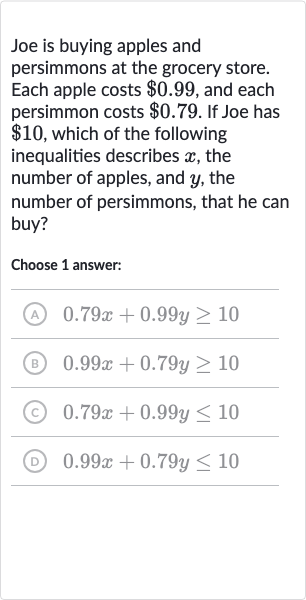AI tutor
Welcome to Bytelearn!
Let’s check out your problem:

Joe is buying apples and persimmons at the grocery store. Each apple costs , and each persimmon costs . If Joe has , which of the following inequalities describes , the number of apples, and , the number of persimmons, that he can buy?Choose answer:(A) (B) (C) (D)
Full solution
Q. Joe is buying apples and persimmons at the grocery store. Each apple costs , and each persimmon costs . If Joe has , which of the following inequalities describes , the number of apples, and , the number of persimmons, that he can buy?Choose answer:(A) (B) (C) (D)
- Determine Cost: Determine the cost per apple and the cost per persimmon. The cost per apple is , and the cost per persimmon is .
- Form Inequality: Since Joe has to spend, the sum of the cost of apples and persimmons must be less than or equal to . This gives us the inequality .
- Check Answer Choices: Check the answer choices to find the inequality that matches our derived inequality. The correct inequality is (D) .
More problems from Write two-variable inequalities: word problems
QuestionGet tutor help
QuestionGet tutor help
QuestionGet tutor help
QuestionGet tutor help
QuestionGet tutor help
QuestionGet tutor help
QuestionGet tutor help
QuestionGet tutor help
